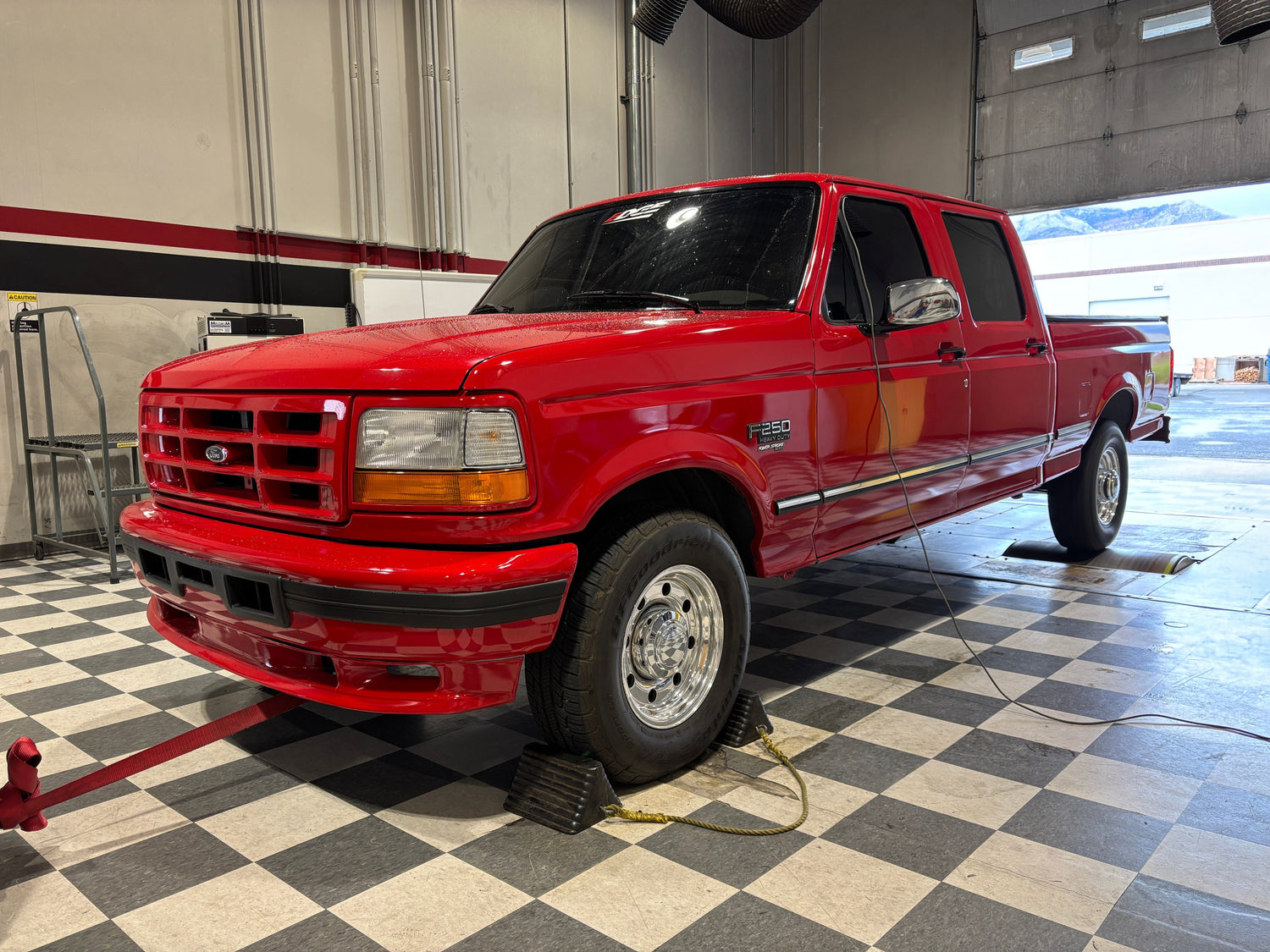table of contents
Before we could start throwing go-fast parts and this old truck, we made some time to strap our 1996 F-250 to the rollers and see what the old Power Stroke still had in it. This truck, nicknamed Project Red Strokes, is destined to become a Lightning-inspired tire shredder, but before we can start adding power, we need a baseline. You can’t improve what you don’t measure, and that’s where the dyno comes in.

Establishing a Baseline
When new, the 7.3L Power Stroke was rated at 215 horsepower and 450 lb-ft of torque at the flywheel. That was back in 1996—almost three decades ago. Our truck has a modest 130,000 miles on the clock, and while it’s been well cared for, time and mileage take their toll. So, we wanted to find out just how close it still is to factory performance before we start upgrading anything.
To get the most accurate data possible, we took the truck to Edge Products’ facility in Ogden, Utah. Their SuperFlow chassis dyno is one of the most reliable setups in the business, and they've been dyno testing diesel trucks for over 20 years. With the truck strapped down and warmed up, we were ready to see what nearly 30 years of use had done to the 7.3L.
The Numbers Don’t Lie
After a few pulls to let everything stabilize, the results came in:
183 horsepower and 360 lb-ft of torque to the rear wheels.

At first glance, that might look like a significant drop from the factory rating, but remember, those factory numbers were measured at the flywheel, not the tires. Between the transmission, driveshaft, and rear differential, a truck like this loses 15–20% of its power through the drivetrain. Once you do the math, our results land right where they should. In other words, this Power Stroke is still performing like it did the day it rolled off the showroom floor.

Why the Dyno Matters
Dyno testing isn’t just about bragging rights, it’s a critical step in any performance build. Establishing a baseline gives us something to compare against as we start modifying the truck. We’ll know exactly how much each upgrade contributes, from intake and exhaust changes to tuning and injectors. Plus, dyno testing helps us monitor how the engine behaves under load, data you just can’t easily get from the driver’s seat.
During the test, we also used the Edge Insight CTS3 digital monitor to data log every run. That allowed us to track parameters like boost pressure, exhaust gas temperature, injection control pressure, and fuel delivery like pulse width and pressure. This information will be invaluable as the build progresses, especially once we start pushing the limits of what the factory hardware can handle. Knowing how the truck responds now helps us identify what needs attention later.
Next Steps for Project Red Strokes
With a solid baseline established, the real fun begins. The goal for Project Red Strokes is to transform this clean, stock F-250 into a Lightning-inspired diesel hot rod, something that not only turns heads but also lights up the rear tires on command. The dyno results confirm we’re starting with a stock and semi-healthy platform, which means we can confidently move forward with performance upgrades.
Next up: airflow improvements, fueling tweaks, and some tuning magic to wake this old-school 7.3L up. Soon we’ll be diving into exhaust modifications, like a 4" turbo back from MBRP exploring how much more we can squeeze out of this truck while keeping reliability in check. Sooner than later, we'll be installing an Irate Diesel E-Fuel kit, as our data shows the mechanical fuel pump isn't performing too well and our front fuel tank is already leaking. Each phase will come with new dyno sessions to measure progress, ensuring that every gain is backed by data, not just seat-of-the-pants impressions.

Wrapping It Up
The dyno doesn’t lie, and in this case, it told us exactly what we hoped to hear—the heart of Project Red Strokes is still strong. With 183 horsepower and 360 lb-ft of torque at the tires, this 7.3L Power Stroke is every bit as stout as Ford built it to be. Now that we know where we stand, it’s time to turn up the wick and start chasing that Lightning attitude.
Stay tuned for Part Four, where we start adding horsepower the old-fashioned way—one bolt-on at a time.






